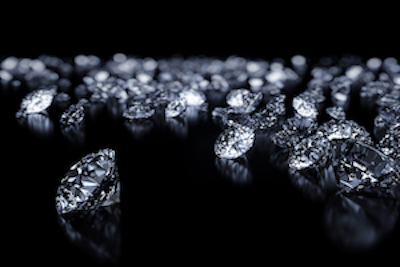Diamonds are included in the asset categories we use as collateral for our low-cost secured asset loans at peer-to-peer lender Unbolted. If you’re contemplating borrowing from Unbolted against a diamond you possess, here’s how we determine its value.
The Gemmological Institute of America (GIA) and the UK’s AnchorCert (both widely trusted and globally respected) issue certificates for diamonds verifying their quality. Just how is that quality assessed? Unbolted’s expert valuation partners (Fellows) assess diamond quality according to the “Four Cs:” the Cut, the Colour, the Clarity and the Carat. Here, we’ll delve a little more deeply into these criteria.
The Cut
There are three optical effects at play that lend cut diamonds different degrees of brilliance: brightness (the reflection of white light), fire (flashes of colour) and scintillation (areas of light and dark).
Reflected light performs better with some proportion combinations than with others. The higher the cut grade, the brighter the diamond will be. “Cut” also refers to the finished diamond’s shape, with shapes other than the conventional round brilliant referred to as “fancy shapes” (or just “fancies”). The most famous cuts are the emerald, the princess, the pear, the heart and the oval.
The Colour
Diamonds occur naturally in numerous colours, ranging from brown to yellow to colourless (the rarest and most valuable).
Though colour differences are usually very subtle, they dramatically influence a diamond’s value. The merest hint of colour makes a big difference, so two diamonds sharing the same weight, clarity and cut can differ markedly in price based on colour alone. As the colour improves in quality toward colourlessness, so does the price per carat. Laboratory techniques standardised by the GIA allow gemmologists to grade a diamond’s colour under controlled conditions, comparing them to “masterstones” - round brilliant diamonds of known colour.
The Clarity
Not many items in nature are completely perfect, and diamonds are no exception. They display inner features called “inclusions” and surface nicks and scratches called “blemishes.” The greater a diamond’s clarity (and therefore value), the fewer the inclusions and blemishes. However, these imperfections do help gemmologists to distinguish between original masterpiece diamonds and copies. A flawless diamond, the top grade in the GIA’s 11-step Clarity Grading System (and exceedingly rare), will show no blemishes or inclusions when viewed by a skilled and experienced grader using a 10-power magnification lens.
Diamond professionals across the world, irrespective of their language, use a set of abbreviations to summarise a diamond’s clarity: VVS (very, very slightly imperfect), VS (very slightly imperfect), SI (slightly imperfect) and I (imperfect).
The Carat (Weight)
The weight of a diamond is precisely measured in metric carats, abbreviated as “ct,” with one carat being the equivalent of 0.2 grams (or seven thousandths of an ounce - 0.007). Each metric carat is divided in one hundred points (i.e., each point represents a hundredth of a carat). If a diamond weighs in at under one carat, say 0.83, it’s said to weigh 83 points or is simply called an “83-pointer.”
As larger diamonds are rarer than smaller ones, the value of the stone doesn’t rise in linear proportion to the weight. A large diamond of 1 carat may weight the same as four 0.25ct diamonds, but it’ll be worth much more than the sum of the smaller stones because of its rarity.



 WhatsApp Us
WhatsApp Us


